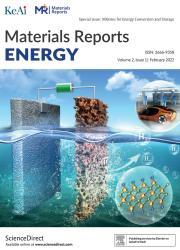2D coordination polymers of transition metals as catalysts for oxygen evolution reaction
IF 13.8
引用次数: 0
Abstract
The oxygen evolution reaction (OER) is a key process in water splitting for hydrogen production, yet its sluggish kinetics pose significant challenges for catalyst development. In this work, we present the first systematic study on isostructural 2D coordination polymers (CPs) based on 1,1′-ferrocenediyl-bis(H-phosphinic) acid, with cobalt, manganese, and cadmium metals as electrocatalysts for OER. These polymers were synthesized via a facile solution reaction, yielding crystalline materials with excellent structural integrity. The electrocatalytic performance of CPs composites, prepared with carbon and phosphonium ionic liquid, was evaluated in 0.1 M KOH using a three-electrode system. Notably, the Co- and Cd-based CPs demonstrated exceptional OER activity, achieving an overpotential as low as 236–255 mV at 10 mA cm−2, surpassing those of many previously reported CP-based OER catalysts. Furthermore, these materials exhibited high stability over prolonged electrolysis, maintaining their activity without significant degradation. This work not only introduces a new class of ferrocenyl phosphinate-based CPs as highly active and durable OER catalysts but also provides valuable insights into their structure-activity relationships, paving the way for future advancements in electrocatalysis.

过渡金属二维配位聚合物作为析氧反应的催化剂
析氧反应(OER)是水裂解制氢的关键过程,但其缓慢的反应动力学给催化剂的开发带来了重大挑战。在这项工作中,我们首次系统地研究了基于1,1 ' -二茂铁-双(h -膦)酸的同结构二维配位聚合物(CPs),钴、锰和镉金属作为OER的电催化剂。这些聚合物是通过简单的溶液反应合成的,产生具有优异结构完整性的晶体材料。在0.1 M KOH条件下,采用三电极体系对碳磷离子液体制备的CPs复合材料的电催化性能进行了研究。值得注意的是,基于Co和cd的CPs表现出了出色的OER活性,在10 mA cm - 2下的过电位低至236-255 mV,超过了许多先前报道的基于cp的OER催化剂。此外,这些材料在长时间电解过程中表现出高稳定性,保持其活性而不显着降解。这项工作不仅介绍了一类新的磷酸二铁基CPs作为高活性和耐用的OER催化剂,而且还提供了对其结构-活性关系的有价值的见解,为电催化的未来发展铺平了道路。
本文章由计算机程序翻译,如有差异,请以英文原文为准。
求助全文
约1分钟内获得全文
求助全文
来源期刊

材料导报:能源(英文)
Renewable Energy, Sustainability and the Environment, Nanotechnology
CiteScore
13.00
自引率
0.00%
发文量
0
审稿时长
50 days
 求助内容:
求助内容: 应助结果提醒方式:
应助结果提醒方式:


